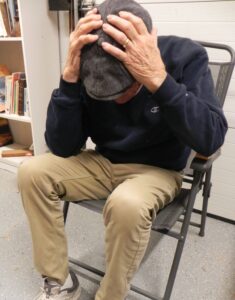After what seems a very long time, Stew and I hung the next to last strake. Planking is an arduous task but despite many obstacles we have almost finished it. And we didn’t need the “crying chair”. The crying chair comes from a conversation I had with my friend Bunny Austin. Bunny was a remarkable Adirondacker. He comes from a family of guideboat builders. His lineage begins with his grandfather Billy who came from Vermont in the mid-1800’s and started building guideboats on the shores of Long Lake. Bunny’s father, Merlie continued the craft. Bunny had little choice but to continue the family tradition.
Well, his nephew, Kevin, also a Long Laker, felt compelled to build guideboats. One day Bunny got a distress call from Kevin. “Uncle Bunny I’m in a terrible mess. Overnight my newly laid plank split right down the middle.” ‘Well, Son, pull up your crying chair and try to think of other things” Bunny replied.
Here I am in my crying chair. So far, during this build I haven’t needed it. I hope my luck continues.

This time around I’m using quarter sawn white pine for the planking. Since the grain runs perpendicular to the surface of the plank, it will bend more easily around the curves in the ribs compared to flat sawn stock. I found quarter sawn stock much easier to work with compared to flat sawn stock.
While struggling to lay out a new plank, I discovered that there was an easier way to lay them out compared to spiling. To do so, lay the new stock over the previously laid plank. Overlap it by at least 5/8″. Reach under the overlapped stock and, with a pencil, trace the forward edge of the previous plank onto the new stock. With a batten connect the traced lines to obtain a smooth curve. Cut along the line and trim it with your block plane. We will now call this the nascent plank.
Lay the nascent plank back on the hull. Locate it at least 4″ below the last plank and make sure it is aligned with the ribs. Now take a compass and mark off the distance from the top of the bevel on the previous plank and the next tick mark. Mark this distance on the nascent plank. Do this for each rib station. Connect the “dots” with a batten and cut away the waste. The photo below shows the procedure.

I have run out of quarter sawn white pine planking stock. I decided to go to Spanish cedar for the last plank. It is a beautiful wood with grain much like mahogany (it is a relative of mahogany but much lighter). The problem I will have to overcome is that it is flat sawn. That means it will resist bending around the curve of the hull. My next post will be devoted to solving how to fit a flat sawn plank on a curved hull.